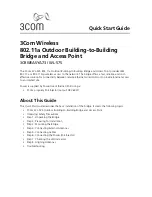
C I S C O C O N F I D E N T I A L - D r a f t A 1
1-2
Cisco Aironet 1250 Series Access Point Hardware Installation Guide
OL-8247-02
Chapter 1 Overview
Guidelines for Using Cisco Aironet Lightweight Access Points
Lightweight Access Points
The lightweight access point (model: AIR-LAP1252) is part of the Cisco Integrated Wireless Network
Solution and requires no manual configuration before being mounted. The lightweight access point is
automatically configured by a Cisco wireless LAN controller (hereafter called a controller) using the
Lightweight Access Point Protocol (LWAPP).
In the Cisco Centralized Wireless LAN architecture, access points operate in lightweight mode (as
opposed to autonomous mode). The lightweight access points associate to a controller. The controller
manages the configuration, firmware, and controls transactions such as 802.1x authentication. In
addition, all wireless traffic is tunneled through the controller.
LWAPP is an Internet Engineering Task Force (IETF) draft protocol that defines the control messaging
for setup and path authentication and run-time operations. LWAPP also defines the tunneling mechanism
for data traffic.
In an LWAPP environment, a lightweight access point discovers a controller by using LWAPP discovery
mechanisms and then sends it an LWAPP join request. The controller sends the lightweight access point
an LWAPP join response allowing the access point to join the controller. When the access point is joined,
the access point downloads its software if the versions on the access point and controller do not match.
After an access point joins a controller, you can reassign it to any controller on your network.
LWAPP secures the control communication between the lightweight access point and controller by
means of a secure key distribution, using X.509 certificates on both the access point and controller.
This chapter provides information on the following topics:
•
Guidelines for Using Cisco Aironet Lightweight Access Points, page 1-2
•
•
Network Examples with Autonomous Access Points, page 1-11
Guidelines for Using Cisco Aironet Lightweight Access Points
You should keep these guidelines in mind when you use a lightweight access point:
•
Lightweight access points can communicate only with Cisco 2006 series wireless LAN controllers
or 4400 series controllers. Cisco 4100 series, Airespace 4012 series, and Airespace 4024 series
controllers are not supported because they lack the memory required to support access points
running Cisco IOS software.
•
Lightweight access points do not support Wireless Domain Services (WDS) and cannot
communicate with WDS devices. However, the controller provides functionality equivalent to WDS
when the access point associates to it.
•
Lightweight access points support eight BSSIDs per radio and a total of eight wireless LANs per
access point. When a lightweight access point associates to a controller, only wireless LANs with
IDs 1 through 8 are pushed to the access point.
•
Lightweight access points do not support Layer 2 LWAPP. They must get an IP address and discover
the controller using DHCP, DNS, or IP subnet broadcast.
•
The lightweight access point console port is enabled for monitoring and debuging purposes (all
configuration commands are disabled when the access point is associated to a controller).
















































